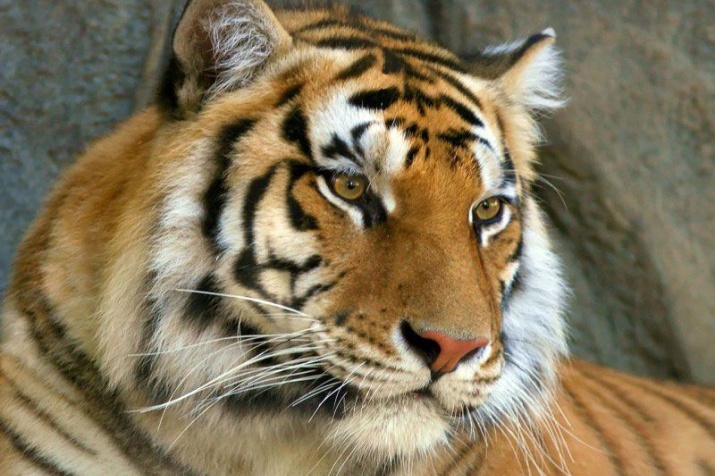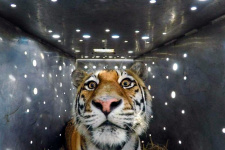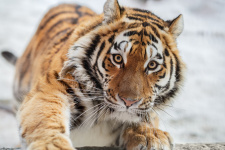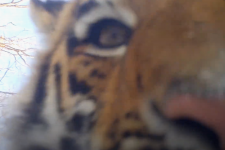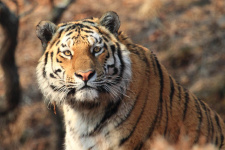Observations help to solve important scientific problems
Protection of endangered species: Siberian tiger
Since 2010, the Russian Geographical Society has supported the Amur Tiger project. Its purpose is to study the state of the Amur tiger population, develop the scientific basis for the conservation of this animal, draw public attention to the problem of the conservation of the Amur tiger in Russia.
The Amur tiger is one of the largest land predators on our planet and one of the smallest subspecies of the tiger listed in the Red Data Book. The only one of its relatives who mastered life in the snow.
By the 1940s, there were less than 50 specimens on the planet. In 1947, the Amur tiger was put under protection - in the USSR, hunting for it was completely banned. But the population grew extremely slowly - by 2010 there were no more than 400.
There are several reasons for this. The first and main one is poaching, and not only the shooting of predators themselves, but also the hunt for herbivores that the tigers feed on. The second is the death of tigers at the hands of local residents, whose cattle from time to time turned out to be prey for the predators. The third is deforestation and reduction in the area where tigers feel comfortable.
Since the Russian Geographical Society began to carry out serious work to restore the Amur tiger population, the situation has improved greatly: by 2019, their number has increased to about 600. About 95% of the total population lives in the Russian Far East, 5% in China; individual specimens are found on the territory of another 12 Asian countries.
In ten years, the following has been done.
• 2010 - The Russian Geographical Society began supporting the Amur Tiger project, the longest-running project for the conservation and study of the predator in the world. The project is being developed by A. N. Severtsov Institute of Ecology and Evolution of the Russian Academy of Sciences together with the Ussuriysky, Lazovsky and Bastak Nature Reserves.
• In 2011, the Russian Geographical Society allocated a grant for the implementation of the long-term project “Study of rare species of animals”. It includes the Amur tiger. The project is implemented by A. N. Severtsov Institute of Ecology and Evolution of the Russian Academy of Sciences.
• In 2011, thanks to this grant, the Permanent Expedition of RAS for Study of Russian Red Data Book Animals built a rehabilitation center for Amur tigers in the village of Alekseevka, Primorsky Territory.
In addition, the scientists used the allocated funds for expeditions and laboratory studies. They studied the state of the population: in different parts of the habitat of the Amur tiger, 122 samples were collected for molecular genetic analysis and DNA was isolated from 78 samples, as a result of which 39 predators were individually identified.
• 2012–2019 - The project "Study of rare species of animals" continued to receive annual grant support from the Russian Geographical Society. As part of scientific research, an analysis was made of the age and sex, and spatial pattern of the Amur tiger population. The study was conducted on the seasonal movements of the predator and its prey using traditional biological and latest molecular-genetic and hormonal non-invasive methods.
• 2013 - at the initiative of the President of Russia Vladimir Putin, the Amur Tiger Center was established under the auspices of the Russian Geographical Society. The main tasks of the Center are the protection and expansion of the predator's habitat, and the restoration of the population. The Amur Tiger specialists are doing everything to eradicate poaching and illegal tiger trade, and also work with the local population to reduce hostility and aggression towards the endangered species.
• 2014 - the first results were produced by the rehabilitation program initiated by the Amur Tiger Center. The program is for the tigers affected by poachers, cubs left without parents. In 2014, after a rehabilitation course, the tiger Boris and the tigress Svetlaya were released into the wild. Since then, Svetlaya has twice bore offspring.
In subsequent years, several more animals successfully completed the rehabilitation and adaptation to wild conditions program.
- 2016 - after the rehabilitation course, the tiger Artyom returned to the wild. Subsequently, he repeatedly was caught on camera traps, allowing scientists to make sure that everything was fine with him.
- 2017 - the tiger Vladik and the tigress Philippa were set free.
- 2018 - the tigress from Lazo, who was orphaned in childhood, and the tiger Saikhan, who, being a tiger cub, was hurt by the poachers, completed the rehabilitation course. In January 2020, the monitoring group found out that the tigress had born offspring.
- 2019 – the tiger Pavlik and the tigress Elena returned to the wild after a rehabilitation course. According to the monitoring group, they adapted well: they successfully hunt and avoid people.
• 2015 - with the support of the Russian Geographical Society, the largest protected area in the tiger habitats was created: Bikin National Park.
• 2015 - with the support of the Amur Tiger Center, a complete state registration of the tiger was carried out, which showed the state of the population throughout the Russian part of the animal’s habitat. It turned out that the largest increase in tiger population was in the area of the Land of the Leopard National Park: the Scientists counted 30 specimens.
• 2015 - studies were conducted in the Bastak Nature Reserve: thanks to a grant from the Russian Geographical Society, new camera traps were installed in it. During the monitoring, scientists collected over two thousand photos of the tiger and analyzed the behavior of the Bastak group.
• 2015 - the Amur Tiger educational project, implemented by the Phoenix Collective Biological Diversity Conservation Program, received a grant from the Russian Geographical Society. Educational posters with accompanying information, children's calendars, bookmarks and rulers were developed and produced as part of the project. These materials should introduce children to the problems of the rare species. Additionally, training seminars for teachers were held as part of the project.
• 2017 - with the support of the Russian Geographical Society, the Amur tiger was recorded in the Ussuriysky Nature Reserve. The monitoring showed the stability of the population, as well as generational change: a new young strong male appeared on the territory, crowding out the previous "owners" of the territory.
• 2018 - with the support of the Amur Tiger Center, WWF and the Department for Hunting of Primorsky Territory, the Far Eastern scientists deciphered the nucleotide sequence of the full-sized mitochondrial genome of the wild Amur tiger. The data is supposed to be used to study tiger diseases, their family ties and biological diversity in general, as well as during examinations.
• 2019 - a grant from the Russian Geographical Society was won by the media project of the production company “Interspot Film”, dedicated to the creation of an educational documentary called “The Return of the Amur Tiger”.
News
The cat prepares to be released into the wild from a rehabilitation center
The scientists of the “Land of the Leopard” National Park shared charming footage
The cat is wandering around the Khingan Reserve "in active search"
Two-month-old cubs are figuring out which one is in charge

